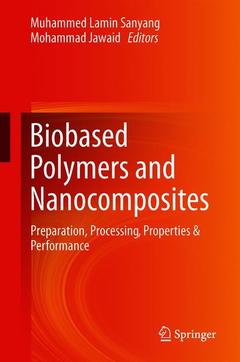Description
Bio-based Polymers and Nanocomposites , 1st ed. 2019
Preparation, Processing, Properties & Performance
Coordinators: Sanyang Muhammed Lamin, Jawaid Mohammad
Language: English
Subject for Bio-based Polymers and Nanocomposites :
272 p. · 15.5x23.5 cm · Hardback
Description
/li>Contents
/li>Biography
/li>Comment
/li>
Chapter 1. Renewable Resource based Polymers.- Chapter 2. Fillers and reinforcements for advanced nanocomposites.- Chapter 3. Cellulose Nanocrystals based Nanocomposites.- Chapter 4. Nanofibrillated cellulose based nanocoposites.- Chapter 5. Bacterial Cellulose Nanocomposites.- Chapter 6. Properties of nano-composites based on different clays and polyamide 6/acrylonitrile butadiene styrene blends.- Chapter 7. Nanotube/Biopolymer Nanocomposites.- Chapter 8. Starch-based Nanocomposites: Types and Industrial Applications.- Chapter 9. Recent Developments in Chitosan Based Nanocomposites.- Chapter 10. Structural properties of protein and their role in Polymer Nanocomposites.- Chapter 11. Polylactic acid(PLA) Based Nanocomposites.- Chapter 12. Biopolymers Based Nanocomposites: Properties and Applications.
Dr. Mohammad Jawaid is currently working as Fellow Researcher (Associate Professor) at Biocomposite Technology Laboratory, INTROP, Universiti Putra Malaysia(UPM), Serdang, Selangor, Malaysia, and also Visiting Professor at the Department of Chemical Engineering, College of Engineering, King Saud University, Riyadh, Saudi Arabia since June 2013. I am also Adjunct Research Advisor, Nan Yang Academy of Sciences (NAS), Singapore and Visiting Scientist to TEMAG Laboratory, Faculty of Textile Technologies and Design at Istanbul Technical University, Turkey. I have more than 14 years of experience in teaching, research and industries. My area of research interests includes hybrid reinforced/filled polymer composites, advance materials: graphene/nanoclay/fire-retardant, lignocellulosic reinforced/filled polymer composites, modification and treatment of lignocellulosic fibres and solid wood, Biopolymers and biopolymers for packaging applications, nanocomposites and nanocellulose fibres, polymer blends.
Muhammed Lamin Sanyang is currently a post-doctoral fellow in the Laboratory of Biocomposite Technology at the Institute of Tropical Forestry and Forest Products (INTROP), Universiti Putra Malaysia. In 2011, he was awarded the Islamic Development Bank (IDB) masters scholarship to pursue his Master’s Degree (MSc) in Environmental Engineering at Universiti Putra Malaysia (UPM). Upon completing his MSc programme in 2013, he was again awarded the Commonwealth Scholarship and Fellowship Plan (CSFP) by the Ministry of Higher Education Malaysia to undertake a PhD degree in the field of Green Engineering at the Institute of Advance Technology (ITMA), UPM.
Identifies the polymer and nanocomposites that can be created from biorenewable resources
Covers the preparation, processing, properties, and performance of these eco-friendly materials
Is up to date with the latest developments and is of interest to researchers as well as those in industry




